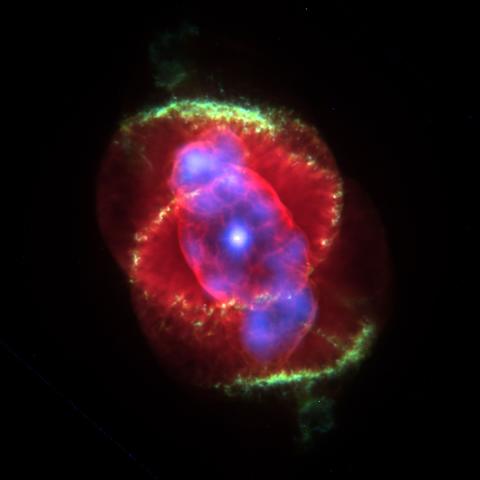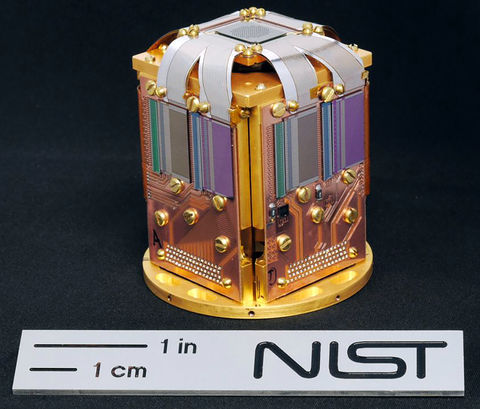EBIT’s Improved X-ray Vision Promises Astronomical Insights
A new upgrade to a NIST instrument boosts resolution by 40 times.

Composite multispectral image of the Cat’s Eye Nebula
Look at an astronomical marvel like the Cat’s Eye Nebula at right, with an average gas temperature about twice as hot as the surface of the Sun. It seems awfully exotic, but it’s absolutely not. The real oddballs in the cosmos are rare havens like our temperate little planet. In fact, 99.9% of what is visible in the sky exists as plasma—an energized state of matter in which electrons break away from neutral atoms, resulting in a sizzling miasma of separated positive and negative electrical charges.
Those electrically charged atoms are called ions, and the forces that create and sustain them in space – such as exploding stars—can be understood in detail only through the radiation they give off. For the most powerful stellar phenomena, scientists particularly need precise data about the X-rays emitted from highly charged ions, those with most, or even all their electrons removed. That has been largely unavailable.
But now, a recently installed state-of-the-art system at the National Institute of Standards and Technology (NIST) will help reveal the dynamics of astrophysical plasmas by providing reference X-ray measurements with unprecedented precision and resolution 40 times better than previously possible.
Every luminous object in space emits radiation in a unique spectrum – a range of specific wavelengths that form a pattern of “lines”—that ranges all the way from infrared to X-rays and beyond. Each chemical element has its distinctive spectrum, and for any particular element, the spectrum changes somewhat depending on its ionization state (number of electrons removed). So, changes in spectrum are a sensitive indicator of the amount of energy that caused the ionization.
Each spectrum “carries invaluable information on composition, structure, temperature, density and many other characteristics of such astrophysical objects,” said NIST scientist Yuri Ralchenko.
The celestial cataclysms of great significance to astrophysicists have energy levels so intense that they drive even massive elements to extremely high ionization levels. “And yet what we know for certain about spectra from such highly charged ions of heavy elements is basically nonexistent,” Ralchenko said. “Nobody has ever measured them. We kind of know what to expect from theory, but theory can never give you an adequate level of accuracy for ions of interest.”
Misunderstanding spectra because of inadequate data has led to many mistakes in astronomy. Perhaps the most remarkable case was the “discovery” of a new element, “coronium,” after observers detected a mysterious green line in spectra from the sun’s corona during an 1869 eclipse. It took decades of progress in spectroscopy for scientists to eventually determine that the mystery line was part of the spectrum of iron with 13 electrons removed.
Now, scientists are reaching that level, thanks to a major instrumentation upgrade to NIST’s workhorse Electron Beam Ion Trap (EBIT for short), one of the best such instruments in the world.
EBIT aims a powerful, controllable stream of electrons at trapped atoms. The more powerful the beam, the more electrons are removed, and the higher the energy of the radiation emitted by the ions. Until now, the EBIT has used sensors that either delivered ultrafine resolution over a very narrow range of the spectrum or detected a wide range of wavelengths with inadequate detail.

That’s why the EBIT team, headed by Ralchenko, last year sought help from another NIST group with expertise in developing transition-edge sensors (TESs). The X-ray TES array, a device invented and continuously improved at NIST, can sense the energy of incoming radiation in extraordinary detail.
It contains a tiny array of superconducting squares kept right on the edge of the transition between zero resistance to current flow and normal resistance. When incoming radiation strikes the array, it raises the temperature and increases the resistance, which registers as an electrical signal. The more energy in the radiation, the larger the signal.
“We measure the current versus time,” said NIST researcher Galen O’Neil from the TES group. “If it’s a flat line, that means you didn’t see an X-ray. If you see a big bump that means you saw a big X-ray. The TES we provided for the EBIT—called NEXT—is the latest generation with the best spectral response and resolution. It is capable of sensing a very broad range of energies very fast.”
“I think the major difference here is that the NEXT spectrometer contains 192 TES microcalorimeters and the previous detector had a linear array with only 4 microcalorimeter pixels,” said NIST project scientist Paul Szypryt. “For this reason, the NEXT spectrometer provides orders of magnitude improvement in X-ray collection efficiency while providing a modest improvement in energy resolution.”
The TES was fitted to the EBIT a couple of months ago, and immediately its performance surprised even the experts. In the first week after installation, “we collected enough data for three journal articles—data that had never been gathered before,” Ralchenko said. “Nobody had expected that it would work so well. In a matter of two hours, we got signals a thousand times stronger and better than what we used to get over weeks of measurements 15 years ago.”

That was possible, in large part, because the NEXT sensor can distinguish between very narrow spectral lines. “EBIT has a lot of lines close to each other,” O’Neil said. “Their spectra are incredibly dense. So trying to interpret them was challenging. But with NEXT, we can see very faint lines and differentiate between two lines that overlap. With a single pixel, we measure for two hours and we might see only four X-rays from one particular line. But we can be confident that it really is a line and measure its energy. That kind of information will be extremely valuable to astrophysicists. Now the EBIT can build up a database so that when somebody observes a new line, we’ve already measured it for them.”
The data also have numerous earthly uses, including assessing laser-produced plasmas, industrial X-ray lithography machines and more. The experimental fusion reactor called ITER, for example, is designed to contain a plasma heated to near 200 million ˚C—10 times hotter than the center of the Sun—to cause collisions between two isotopes of hydrogen, which fuse into helium, releasing energy.
“The primary impurity in the ITER reactor will be tungsten,” Ralchenko said, with 60 or more of its 74 electrons stripped off. “It is extremely important to have an accurate understanding of the spectrum. If some of the energy of your collisions, instead of increasing kinetic energy, goes instead into exciting tungsten ions, that energy is simply lost, gone. Radiative power losses of that sort are one of the most important problems in fusion science.”
The upgraded EBIT with the NEXT sensor has just begun to show its capabilities. “The bottom line,” said Ralchenko, “is that NEXT opens for us a completely new chapter.”

